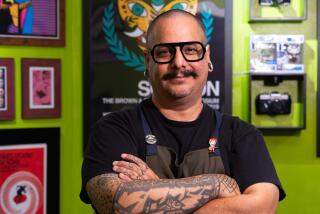A tribal take on comic art
- Share via
This summer is overflowing with images of familiar superheroes and ominous villains, and the world of American Indian art is digging up its own version of the comic art form at the Museum of Indian Arts and Culture in Santa Fe, N.M.
“Comic strips were the first accessible form of mass media made available on reservations, and there was this immediate connection between native people and that type of work,” said Antonio Chavarria, curator of ethnology, who organized the Comic Art Indigene exhibit. “There was no language barrier, and the whimsical stories were a very familiar tradition.” Comics were consumed as a recognizable and legitimate form of storytelling.
Most of the art on display is a collection from regional artists, including Santana Shorty, Rose Bean Simpson and Marty Two Bulls, and their interpretation of politics, humor, culture and identity. Some of the contemporary work is based on older comic-art images; for instance, Diego Romero makes drawings which are interpretations of the Marvel Comics of the 1960s.
Many of the images seek to reclaim stereotypes used in early comic art depicting Indians as savage, warmongering primitives or the passive, trusty sidekick. One example: a red, white and blue pictograph from Canyonlands National Park in Utah of a shield-carrying Pueblo warrior that could almost prefigure Jack Kirby’s Captain America.
The Kiowa artist Silverhorn, who features a Kiowa trickster and mythical folk hero named Saynday, uses elements adapted by later comic strip artists to show action, the passage of time and movement.
“Comics are just another way to tell stories,” added Chavarria, “they are a narrative art form that reinforces the beliefs and symbols of a people and a place.”
The exhibit runs through January.
-- Liesl Bradner
More to Read
The biggest entertainment stories
Get our big stories about Hollywood, film, television, music, arts, culture and more right in your inbox as soon as they publish.
You may occasionally receive promotional content from the Los Angeles Times.










